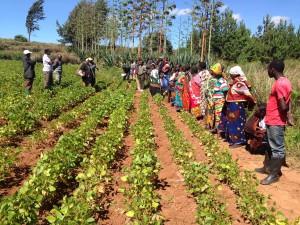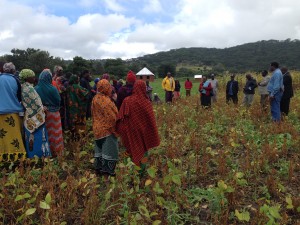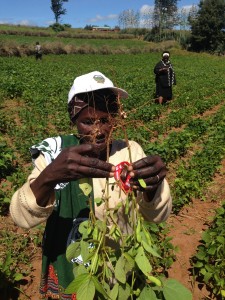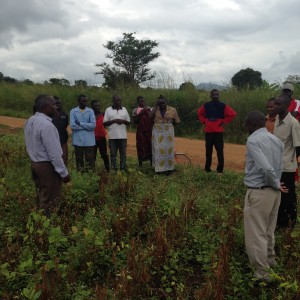North: South divide in Tanzania soybean training
Updated 20 July 2017 SILT The delay in the rains in many parts of Tanzania during the soybean planting season meant that around half of the demo plots were planted up to 6 weeks later than normal. Usually farming season in the Southern Highlands starts from November/December but this year it was as late as January. This was a salutary reminder for the SILT team of the impact of climate uncertainty on small-scale farmers in Africa. In the north the season started in Feb/March. The soybean demonstration training days will happen in early July 2017 in the north.
David Kijazi, the AFAP project manager responsible for the SILT demonstration plots explains:
“We have completed the training at the demonstration plots in the Southern Highlands – the final training will happen in early July, reflecting the very different times that planting could take place. Soybean needs to be planted when the ground is moist but after planting too much rain can be as challenging for farmers as too little.”
The attendance figures for the soybean demonstration plots are listed below broken down by location and gender.
In summary the 2017 soybean demonstration training days held in the Southern Highlands attracted:
- 549 farmers of overall, of which
- 335 (61%) were men
- 214 (39%) were women
- 305 (48%) were under 35 – including a group of 120 pupils from the local primary school
In 2016 common bean was the crop being demonstrated – the training days held in the Southern Highlands attracted:
- 245 farmers overall, of which
- 153 (62%) were men
- 92 (38%) were women
- 191 (78%) were estimated to be under 35
David Kijazi continues: “we work with the local extension teams to recruit the farmers to come to the demonstration plots. This year we saw a big increase in the numbers attending, whilst the proportion of men and women stayed the same. We were more rigorous in the way that we collected data on the attenders especially age data. Whilst it appears we attracted less farmers under 35, this may be a function of the way we collected the data.
We need to explore further why more people came to the training this year. Soybean is a more complicated crop to grow and so it may appeal to more experienced farmers and more farmers want to pick up skills in this area.”
Photos from AFAP soybean training sessions 2017: Top left Isuka 2 May; top right Sangara 3 May; bottom left Isuka 2 May and bottom right Madaba 25 April [Photos credit: AFAP]
| Region, District, Village | Farmers attending field day 2017 | Other promotional activity | ||||
| Male | Female | Total including youth | Youths | Receiving soybean planting leaflets | Estimated number of people who have passed at soy bean demo plots in a season | |
| Southern Highlands | ||||||
| Ruvuma,Namtumbo, Namanguli | 74 (65%) | 40 (35%) | 114 | 23 | 70 | 280 |
| Ruvuma,Madaba, Madaba | 22 (82%) | 5 (18%) | 27 | NK | 0 | 685 |
| Njombe, Makambako Town Council, Usetule | 89 (61%) | 56 (39%) | 145 | 120 | 0 | 325 |
| Njombe, Makete, N’gonde | 18 (62%) | 11(38%) | 29 | 88 | 0 | 175 |
| Mbeya, Mbeya District Council, Mapogolo | 38 (49%) | 39 (51%) | 77 | 20 | 78 | 435 |
| Mbeya, Chunya, Chalangwa | 37 (66%) | 19 (34%) | 56 | 21 | 90 | 440 |
| Iringa, Iringa District Council, Kiponzelo | 38 (76%) | 12 (24%) | 50 | 18 | 60 | 480 |
| Iringa, Kilolo, Isuka | 19 (37%) | 32 (63%) | 51 | 15 | 0 | 210 |
| Total South | 335 (61%) | 214 (39%) | 549 | 305 (48%) | 298 | 3030 |
| Average South | 42 | 27 | 69 | 43 |
75 – at 4 locations where given out 37 overall |
379 |
The attendance figures for the soybean demonstration plots are listed below broken down by location and gender. This shows that attendance at soybean demonstration plot field days was significantly less in north then the south. Attendance was also very much less than it was the previous year for the common bean farmer training days.
David said: “There is not a strong tradition of growing soybean in the north, but even so the attendance was disappointing in terms of reach. It will be interesting to see how successful SILT is overall in the North with other campaign approaches and to explore further why attendance was so much lower than we had anticipated.”
In summary the 2017 soybean demonstration training days held in the Northern Highlands attracted:
- 172 farmers of overall, of which
- 97 (56%) were men
- 75 (44%) were women
- 34 (20%) were under 35
In 2016 common bean was the crop being demonstrated – the training days held in the Southern Highlands attracted:
- 888 farmers overall, of which
- 489 (55%) were men
- 399(45%) were women
- 788 (89%) were estimated to be under 35
| Region, District, Village | Farmers attending field day 2017 | |||
| Male | Female | Total including youth | Youths | |
| Northern Highlands | ||||
| Kilimanjaro, Hai, Kwasadala | 20 (54%) | 17 (46%) | 37 | 7 |
| Kilimanjaro, Moshi Distric, Uparo | 17 (51.5% | 16 (48.5%) | 33 | 8 |
| Arusha, Karatu, Changarawe | 16 (89%) | 2 (11%) | 18 | 6 |
| Arusha, Arusha District, Nduruma | 17 (63%) | 10 (37%) | 27 | 2 |
| Morogoro, Kilosa, Pea Pea | 21 (55%) | 17 (45%) | 38 | 6 |
| Morogoro, | 6 (31.5%) | 13 (64.5%) | 19 | 5 |
| Total | 97 (56%) | 75 (44%) | 172 | 34 |
| Average | 16 (56%) | 12.5 (44%) | 28.5 | 5.5 |




